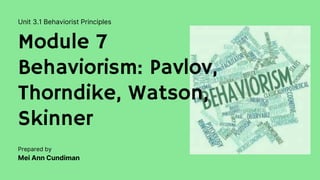
Module 7- Behaviorism
- 1. Module 7 Behaviorism: Pavlov, Thorndike, Watson, Skinner Unit 3.1 Behaviorist Principles Prepared by Mei Ann Cundiman
- 2. Objectives: In this module, we are expected to attain the following learning outcomes: explain the basic principles of behaviorism. 01 02 03 determine how to use rewards in the learning process more effectively. make a simple plan applying the primary laws of learning.
- 3. Introduction • The theory of behaviorism focuses on the study of observable and measureable behavior. • It emphasizes that behavior is mostly learned through conditioning and reinforcement (rewards and punishment). • It does not give much attention to the mind and the possibility of thought to process occurring in the mind • Contributions in the develoment of the behaviorist theory largely came from Pavlov, Thorndike, Watsons and Skinner.
- 4. Advance Organizer Behaviorism Classical Conditioning (Pavlov/Watson) Connectionism (Thorndike) Operant Conditioning (Skinner) Primary Laws Law of Effect Law of Exercise Law of Readiness Reinforcement Shaping of Behavior
- 5. • Russian physiologist • "Classical Conditioning" or stimulus substitution • Experiment in meat, dog and a bell Ivan Pavlov 1849-1936 Initially, Pavlov was measuring the dog's salivation in order to study digestion. This is when he stumbled upon classical conditioning. Brief History
- 6. Pavlov's Experiment (classical conditioning) Bell (neutral stimulus) Stage 1: Before conditioning Stage 2: During conditioning Bell (neutral stimulus) Paired with Stage 3: After conditioning Meat (Unconditioned Stimulus) Bell (Unconditioned Stimulus) No Response Salivation (Unconditioned response) Salivation (Conditioned Response)
- 7. Bell (neutral stimulus) Stage 1: Before conditioning No Response The unconditioned stimulus is one that unconditionally, naturally, and automatically triggers a response. The unconditioned response is the unlearned response that occurs naturally in response to the unconditioned stimulus. In the before conditioning phase, an unconditioned stimulus is paired with an unconditioned response. A neutral stimulus is then introduced.
- 8. Stage 2: During conditioning Bell (neutral stimulus) Paired with Meat (Unconditioned Stimulus) Salivation (Unconditioned response) The conditioned stimulus is a previously neutral stimulus that, after becoming associated with the unconditioned stimulus, eventually comes to trigger a conditioned response. The conditioned response is the learned response to the previously neutral stimulus. The during conditioning phase involves pairing a neutral stimulus with an unconditioned stimulus. Eventually, the neutral stimulus becomes the conditioned stimulus.
- 9. Stage 3: After conditioning Bell (Unconditioned Stimulus) Salivation (Conditioned Response) The resulting response is known as the conditioned response The conditioned response is the learned response to the previously neutral stimulus. In the after conditioning phase, the conditioned stimulus alone triggers the conditioned response.
- 10. Pavlov's Findings Once the dog has learned to salivate at the sound of the bell, it will salivate at other similar sounds. Stimulus Generalization If you stop pairing the bell with the food, salivation will eventually cease in response to the bell. Extinction Extinguished response can be "recovered" after an elapsed time, but will soon extinguish again if the dog is not presented with food. Spontaneous Recovery The dog could learn to discriminate between similar bells (Stimuli) and discern which bell would result in the presentation of food and which would not. Discrimination Once the dog has learn to conditioned to associate the bell with food, another unconditioned stimulus, such as light may be flashed at the same time that the bell is rung. Eventually, the dog will salivate at the flash of the light without the sound of the bell. Higher-Order Conditioning
- 11. In reality, people do not respond exactly like Pavlov's dogs. There are, however, numerous real-world applications for classical conditioning. Teachers are able to apply classical conditioning in the class by creating a positive classroom environment to help students overcome anxiety or fear. Pairing an anxiety- provoking situation, such as performing in front of a group, with pleasant surroundings helps the student learn new associations. Instead of feeling anxious and tense in these situations, the child will learn to stay relaxed and calm.
- 12. • American psychologist • Connectionism Theory • Founder of the Modern Educational Psychology • Connectionism is the key to learning Edward Lee Thorndike 1874-1949 Learning is the result of associations forming between stimuli (S) and responses (R). Such associations or "habits" become strengthened or weakened by the nature and frequency of the S-R pairings. Brief History
- 13. • The main principle of connectionism was that all learning could be adequately explained without considering any unobservable internal states. Thorndike's theory on connectionism, states that learning has taken place when a strong connection or bond between stimulus and response is formed and came up with three primary laws. • The model S-R theory was a trial and error learning in which certain responses came to be repeated more than others because of rewards.
- 14. Three Primary Laws Law of Effect Connection between stimulus and response is strengthened when the consequence is positive (reward) and the connection between the stimulus and the response is weakened when the consequence is negative. Law of Exercise This tells us that the more S-R (stimulus-response) bond is practiced the stronger it will become. "Practice makes perfect" seem to be associated with this. . Law of Readiness This states that the more readiness the learner has to respond to the stimulus, the stronger will be the bond between them.
- 15. Principles Derived from Thorndike's Connectionism: • Learning requires both practice and rewards (Law of effect/exercise) • A series of S-R connections can be chained together if they belong to the same action sequence (Law of readiness). • Transfer of learning occurs because of previously encountered situations. • Intelligence is a function of the number of connections learned.
- 16. THANK YOU!